The South African Fruit Season

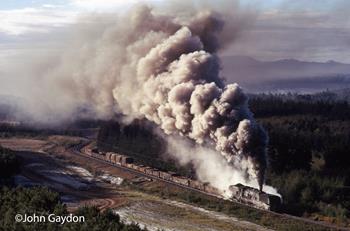
I arrived in South Africa for the second time on late December, 1974. Following 4 months in Europe including two weeks riding the Rheine Norddeich line with 012 three cylinder Pacifics, which consistently clocked up 120 kph or 75 mph speeds for sustained periods, I managed to get myself a job in Johannesburg with the intention of leaving in time for the Cape Fruit season. As it turned out, 1975 was the last year there was a full steam roster with many 14CRBs and GEA Garratts heading trains.
I moved in to a flat in Hillbrow, a place I believe is totally off limits and the crime capital of South Africa now! I was staying with an Aussie and a Pom, both railfans. Anyway, I worked hard for 3 months, spent very little and used the opportunity to build up my cash supply. I was very lucky because the Afrikaans supervisor was on leave and when he came back he made the job very difficult. By mid March, it was time to leave, so I quit, purchased a 2 year old Peugot 404 wagon off another Aussie who was heading home for just $1600 rand and took off for Capetown as fast as we could go.

The rail line from Capetown ran across the flats through a lush valley. Then it hit the escarpment. At this point there was a steep, fabulous climb to the top of Sir Lowry’s pass that really tested the GEA Garratts.

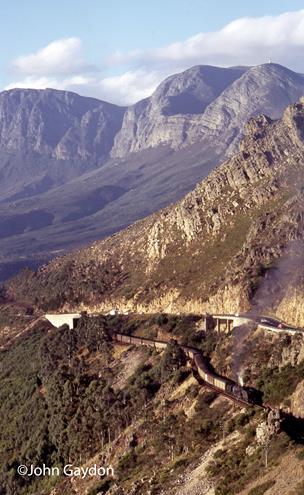
Fortunately, most of the time the climb from Capetown included empty cars on their way to pick up a load of fruit or other produce. This area supplies a huge portion of South Africa’s grain and fruit production to the port of Cape Town.
By all accounts, this is an incredible stretch of railway line. It was absolutely freezing with heavy frosts in the morning, the fog often only lifting by lunch time. The line crossed two mountain passes, Sir Lowry’s and Houw Hoek. Both were spectacular.
Ascending Sir Lowry’s, the line snakes up the escarpment in spectacular fashion. It is a real cliff hanger. In the morning you could see the mist rising, which, in itself led to interesting photos.
The main motive power were GEA hand fired Garratts, I think at that time they were the largest hand fired engines in the world. The second main class of locomotive power was the 14 CRB, at that stage only working in this area of the country. One of the challenges of latter day railfans was the lack of variety in steam motive power. For instance, in the early 1960s I photographed many classes of steam on my local area, the Short North of NSW Australia. By 1970 half of those were no longer hauling trains. Except for the fact they are a lot older now, I envy those who were taking shots in the 1950s when steam was king.
After crossing Sir Lowrys, the line descends to the orchid areas and then crosses Houw Hoek to the Eastern plains of the wheat belt. This is perhaps more spectacular than Sir Lowry’s as the line winds through a narrow gorge flanked by high mountains.
I was travelling with Mike Grainger who went with me on my famous Mozambique expedition, and Kerry James an engineman from New Zealand I first met while riding the Kingston Flyer in the south of that country.
Everyone Was There
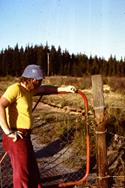
The crew descending on the area at that time included some of the best known railway photographers of the time. I met Dusty Durrant, Charlie Lewis, Peter Stowe, Alan Jorgensen, Greg Tripplet and many others. All of these have many books and photos published. It was quite an occasion for we steam buffs.
Charlie and Peter had high positions in the South African Railways, and could organise many things. The “cade” road which followed the line was for railway personnel only, but by arrangement we were able to obtain a key to the padlocked gates from the Sir Lowry’s station master. This made life a lot easier. Some of the gates had 5 or more padlocks, but one always fitted our master key.
In reality, this was the beginning of the big adventure. At this stage we had no idea what was in store for us later on the trip.
Bethlehem
Our first stop was the rail town of Bethlehem. Nothing to do with the bible, or Israel, but a town famous amongst railfans for the spectacular line from there to Ladysmith and on to Bloemfontein. I visited this line several times as it was relatively close to Johannesburg. Here is one of the pictures from this particular trip.
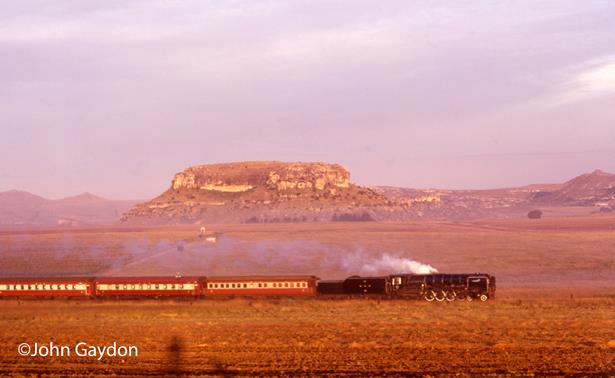
Motive power on this line was the 25NC, a 4-8-4 locomotive and the largest non articulated loco in the country. An Aussie, Mike Carter, worked as a steam driver there for a few years and photographed the area. As you can see from the above shot, it is a great area for railway photography.
There was no time to waste as the fruit season was underway, so we headed straight for Capetown from here. We had a small tent we all snuggled into, and a gaz camping stove for cooking. The menu varied from delicious Barb-Que steaks cooked on the Brie and purchased from local butchers to Kerry’s famous cheap dish of rice and milk. The meat was amazing. Best I ever had. We really lived on the cheap in those days and this was how I managed to cover so much of the world before running out of money.
Every morning there would be a thick frost and it was freezing as we headed for the spot to photograph the morning fruit express. Sometimes it was a single GEA, and if we were lucky, a 14CRB headed the Garratt. The picture below was on one of those occasions.

You can see the thick frost on the ground. After getting the shot of this train near the bottom of the hill, we would rush up the dirt road nearly colliding with the rest of the motorcade to Sir Lowry’s station to get a second photo. Fact was that it was a really hard climb for the locos with a full load of apples, so the train went fairly slowly.
This gave us time to scurry up the dirt road, through a couple of gates and get set for the next shot.
On this occasion, the sun shone under the shadow of the smoke to provide a spectacular photo opportunity.
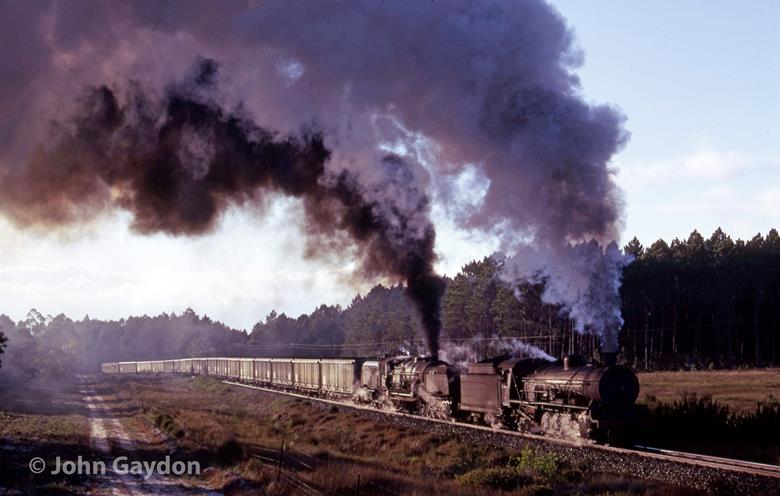
Sir Lowry’s was a relatively straight, though steep climb. The helper loco detached at the summit and the GEA continued on to the Port of Capetown with apples bound for Europe.
Houw Hoek
West of Sir Lowry’s the countryside changed. Instead of forests and open spaces, the line entered a steep gorge. This was on the section between Elgin and Bot River.
A feature of this pass was a magnificent open girder bridge where the line crossed the gorge.
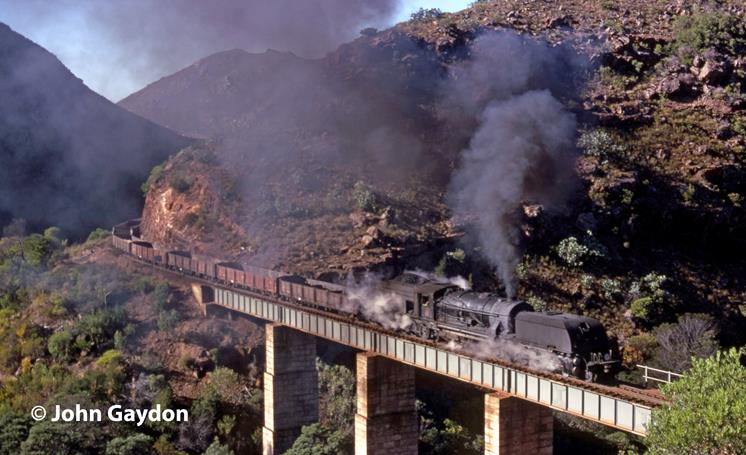
In some ways the view leaving the gorge was even more spectacular. This shot and the next were both taken during the Cape fruit season in 1975.

After leaving Hoew Hoek, the line continues to Bot River, where the engine takes on water. From there it is a journey over undulating plains and wheat fields.
I came back to the Western Cape after my Mozambique adventure. On my return to civilization, I wanted to get a job and save up for travel to South America the following year. My first thought was to get a job as an engineman at Port Elizabeth. At that stage suburban trains were still hauled by 16CR Pacifics. I was told you could sign on as a cleaner for $170R a month and then graduate quickly to fireman. In the end, the pay got me. I managed to get a job as an electronic technician, my chosen trade at a much higher pay. This turned out very well for me as at one stage I was earning 1100R a month on a special project and filled my wallet for the next trip!
Anyway, All these years later, I am having trouble recalling the exact route of my grand trip by train. I had a couple of weeks before starting work and spent the time doing a grand rail tour. I recall there were some 3,000 kms behind steam on this trip, something that just can’t be done now!
On my arrival in Cape Town, I hired a car to photograph trains on the wheat belt beyond Hoew Hoek. The catch was that there was a 250 km daily limit, after which excessive mileage was charged. I got around this by travelling up the dirt road beside the track in reverse. I am sure the loco drivers found it very amusing seeing me chase them backwards!
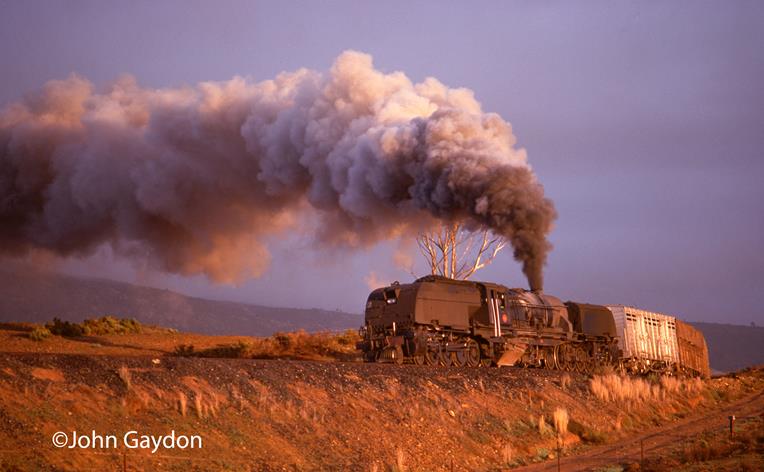
At this time of year, the lighting was softer, and the scenary quite brown, typical of a wheat growing area.
I think you might agree that this was a very special part of South Africa, perhaps after Natal, the last place with amazing scenary and hand fired garratts. I am left with fond memories, and in my opinion, some great shots of history.







Hi John,
I really enjoyed reading your stories and looking at pictures of steam days gone by.
I have good memories of the Riversdale, Mossel Bay, Oudtshoorn line as a child. We would travel by train down there to visit my grandparents back in the late 70’s. We love train travel, even to this day!
I’m privileged to be part of an active steam preservation club here in Johannesburg which is running steam hauled trains on a regular monthly basis.
Very sad that those days are gone.
regards,
Michael
Hi Michael,
Thanks for the comment. Plenty more to come. You are lucky to still have steam trains running. The Zig Zag Railway, the steam railway I belong to hasn’t run any trains for months due to government regulations. These days you have to fill out a mountain of paperwork before you can run a train.
You should provide a link to your website. You never know who might be reading these articles.
John
Hi John
My Dad was a driver on the Bethlehem Bloemfontein line at the time you were here in 1974. do you maybe have photos of that time, I am collecting only photos of his engine (25nc 3415).
Regards
Francois
Hi Francois,
Yes, I definitely have some great shots of the Bethlehem line. After hearing from you I will make this a priority! A friend of mine, Mike Carter was driving there at that time too.
I will see what shots I have of 3415. I have over 50 photos on that line. We used to visit from Johannesburg on weekends.
Hi John
Thank you for the reply, Mike send me also a couple of photos. He knows my dad well.
Regars
Hi John
When my Dad had 3415 he painted her numberplate and the bord on the wing blue.
Regards
I Think I may have a picture of this engine on the Bethlehem line. Must get to that soon. There were some spectacular photos.
Francois,
If you go back to http://steamtrainstories.com you can read a post on Bethlehem including the 25 with blue smoke deflectors.
Hi John,
I was a fireman at Paarden Eiland Steam Depot in Cape Town during the early 60’s and 70’s.
We used to work the Cape Town / Caledon line over Sir Lowry’s Pass with 14C / 19C and especially the GEA locos.
I am busy writing a book with short, some lengthy, stories of my more “colorful” experiences during my 42 years on the SA Railways.
I have already completed 8 stories and would now like to add photos, I have many great photographs of the various places that I worked but, with your permission, would also like to add 2 of your photos of Sir Lowry’s pass.
The book will be for my personal use only and not for sale.
Regards,
Mervyne
Hi Mervyne,
Thanks for the comment. I think you should consider sharing your stories with the many steam buffs around the world. I would be happy to include a few of them on this site. It is watched by many who derived pleasure from South African steam trains. All I ask is you credit me with the photos you use and provide a link to http://steamtrainstories.com
Please send me a copy regardless, as I would love to read it. If you were still working on the line in 1975, I may have met you!
John
Who is Mike Carter? Mike came to South Africa in 1973 in order to live his dream – working on main line steam. Mike’s steam career started at Springs where he worked the passenger link with driver Piet Grobbelaar – class 24s between Springs & Nigel. Bigger and better things were in store, and in 1975 Mike transferred to Bethlehem where some 22 25NC 4-8-4s had been relocated from the Cape region. Mike had his own engine, 3416 “Queen of Sheba” with driver Ampie van Dijk, working the eleven man passenger link. In 1980 Mike was appointed driver (steam) where he worked until the end of steam in 1987.
http://www.fullsteamahead.co.za/ – Mike’s website
https://www.facebook.com/groups/158259854332178/ More old steam fanatics – mostly South Africans
Thanks Smitie,
I remember Mike from before he ventured to South Africa in Australia and we met a couple of times at Bethlehem. He has some great pictures. I did try to contact him through his website, but unfortunately no reply.
Thanks for your contribution.